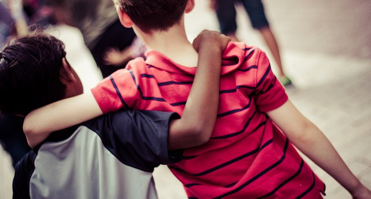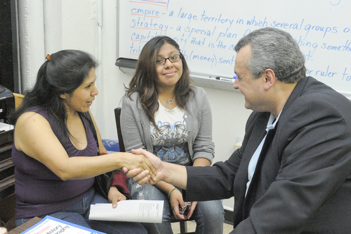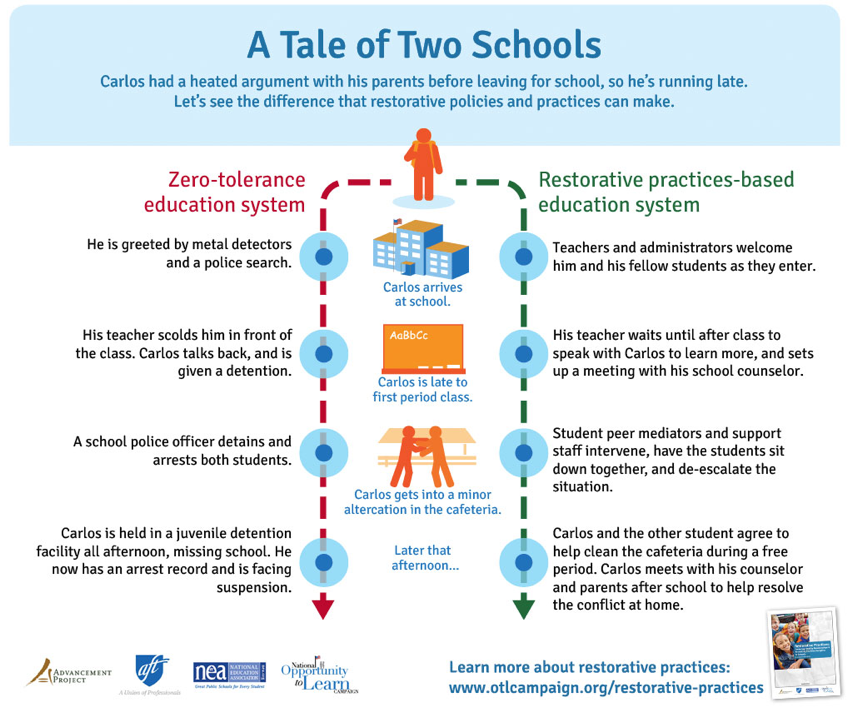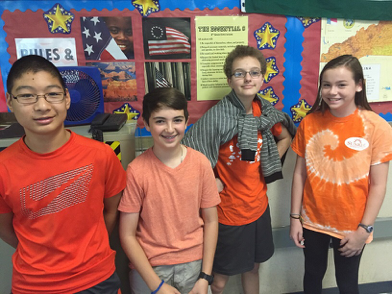Rethinking Discipline
 For students to learn and grow, educators recognize the need for positive relationships and interactions among students, teachers, and other adults. Students need learning environments that address their social and emotional health as well as their academic needs.
For students to learn and grow, educators recognize the need for positive relationships and interactions among students, teachers, and other adults. Students need learning environments that address their social and emotional health as well as their academic needs.
To achieve this, more schools are moving away from Zero Tolerance discipline policies, which focus on administering punishment, to implementing restorative practices that create safe, supportive environments for addressing conflict and building communities and relationships.
The effort to reduce violence and bullying in schools, while increasing social-emotional and academic success is incomplete without approaching all elements with a racial equity and anti-oppression lens.
- Reversing inequity in education means asking difficult questions about school policies, and the overrepresentation of youth of color (predominantly black and brown students) in disciplinary action and carefully examining the school discipline climate and disproportionate achievement outcomes.
- Schools need to be better equipped to confront homophobia and homophobic language and teasing, and create welcoming environments for LGBTQ students, as well as families with gay parents.
 “The School Board changed the policy to mandate that before a child is suspended, you must show that multiple levels of support were exhausted first prior to suspension. Before this, many students were being suspended for minor infractions.” – Principal Godwin Higa
“The School Board changed the policy to mandate that before a child is suspended, you must show that multiple levels of support were exhausted first prior to suspension. Before this, many students were being suspended for minor infractions.” – Principal Godwin Higa

Restorative Practices and Restorative Justice

Integrated into classrooms, curriculum and culture, restorative practices and equitable discipline policies can contribute to creating a safe school climate. Restorative Practices take into consideration the disproportionate impact on students of color, students with disabilities, or at-risk students. Restorative Practices are also the informal and formal processes that precede and prevent wrongdoing. Though impossible to prevent all conflict, Restorative Practices focus on establishing discipline policies and practices that ensure fairness and equity for all students.
Restorative practice doesn’t just mean avoiding suspensions and expulsions. If it’s restorative, it is never negligent nor a “to” or a “for”; it is always a “with”. It is a victim-centered process that brings about healing on specific and general levels, with the student part of an agreement conversation about how the situation is handled and repaired. (Saheli)
“Just because someone apologizes, it doesn’t mean anything has been repaired.”
—Dr. Ammar Saheli
Restorative Justice is a part of this effort that focuses on conflict resolution using empathy, knowledge and awareness with interventions for reducing suspensions, expulsions and disciplinary referrals.
Community conferencing, community service, peer juries, preventative and post-conflict resolution programs, peer mediation, informal restorative practices, and  social-emotional learning (SEL) are additional types of restorative practices that emphasize:
social-emotional learning (SEL) are additional types of restorative practices that emphasize:
- Relationships
- Giving voice to the person harmed and who caused the harm during conflict
- Engaging with collaborative problem-solving
- Encouraging dialogue-based decision-making processes
- Developing plans that lead to repairing the harm done
ACTION POINTS/THINGS TO CONSIDER:
- What does your data tell you about disproportionate disciplinary actions at your school?
- What are adults doing to build community in our schools/districts? The tighter adults are in the building, the better the impact will be on the students. Strong adult to adult communities are the best examples for students. This piece is consistently missed.

RESOURCES


